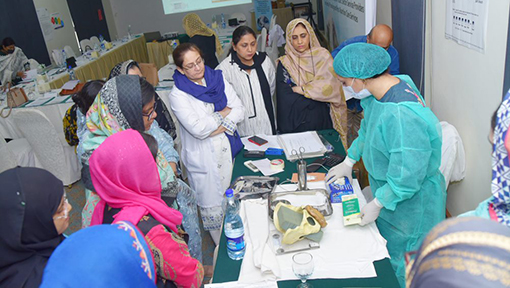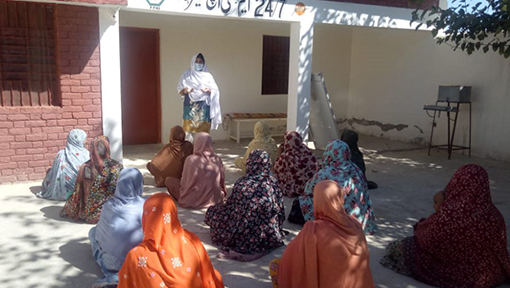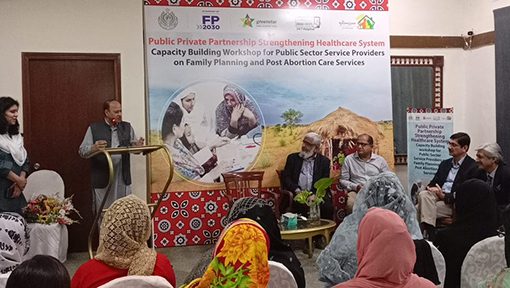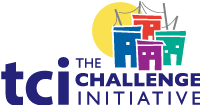Pakistan: Service Delivery
- Home
- Help and Support
- Close
- Toolkits
- Global Toolkit
- AYSRH Toolkit
- Hub Toolkits
- Core High-Impact Practices
- Gender Essentials Mini Course
- Close
- Resource Collection
- Community of Practice
- Coaching
- Log In/Register
- My Profile
- English
Post-Abortion Care
What Is It?
 The World Health Organization defines spontaneous abortion (miscarriage) as the spontaneous loss of a clinical pregnancy before 20 completed weeks of gestation or, if gestational age is unknown, the weight of the fetus less than 500 g or less (WHO 2002). It is estimated that, worldwide, up to 32 million pregnancies each year will end in spontaneous abortion, compared to approximately 20 million induced abortions during the same period.
The World Health Organization defines spontaneous abortion (miscarriage) as the spontaneous loss of a clinical pregnancy before 20 completed weeks of gestation or, if gestational age is unknown, the weight of the fetus less than 500 g or less (WHO 2002). It is estimated that, worldwide, up to 32 million pregnancies each year will end in spontaneous abortion, compared to approximately 20 million induced abortions during the same period.
Postabortion care (PAC) is an integrated service delivery model that includes both maternal health and family planning interventions and is curative and preventative. The services include As part of a larger reproductive health strategy, PAC can be vital in reducing the unmet need for FP, which can prevent future unplanned/ mistimed pregnancies, decrease the incidence of repeat abortion and miscarriage and decrease maternal morbidity and mortality.
What are the benefits?
In Pakistan, 10-12 million women conceive annually. It is estimated that 4.2 million pregnancies are unwarranted, and 2.2 million end up in unsafe abortions. With the current total fertility rate (TFR) of 3.45, every fourth child in Pakistan dies because of lack of nutrition and birth spacing. A woman can conceive after 10 days/within 2 weeks of a miscarriage, but she should wait a minimum of six months until her subsequent planned pregnancy.
Postabortion care (PAC) is an evidence-based high-impact practice that has proven to create beneficial results for women. PAC includes the opportunity to save a woman from complications due to an unwarranted (unwanted) pregnancy or one disregarded for her health, leading to low maternal mortality. World Health Organization (WHO) advises adopting a family planning In case of oral contraception, WHO advises immediately after an abortion or a pregnancy complication and continuing birth spacing for at least six months. This period allows the woman to rejuvenate and achieve optimum health if she wants to plan another child and eliminate the chances of low-birth weight, premature birth and maternal anemia.
This approach provides:
- Treatment of emergency complications, including MVA and surgeries
- Voluntary family planning counseling, including the provision of contraception (IUCDs, implants and pills)
How to implement
There are five elements/steps for PAC.
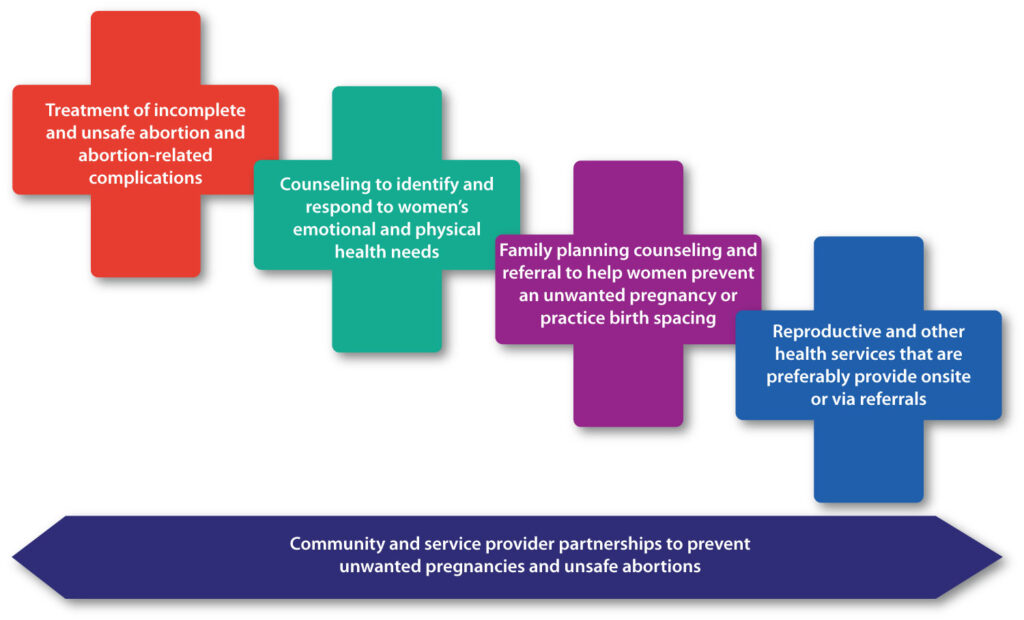
Step 1: Treatment of incomplete and unsafe abortion and abortion-related complications
If a woman comes to a trained service provider in an emergency, it is her right to obtain quality services under a comfortable environment. The provider must determine and identify the emergency need and provide adequate services to women who have incomplete and unsafe abortion and/or abortion-related complications.
There are several training manuals that can be used to train providers on PAC.
- National Committee for Maternal and Neonatal Health (NCMNH) of Pakistan’s PAC resources
- Ipas’ Woman-Centered Postabortion Care Reference Manual
- Jhpiego’s Postabortion Care Curriculum: Reference Manual
In an emergency, either a manual vacuum aspiration (MVA) is conducted (doctors and LHVs can perform) or surgery in case of abortion-related complications (only surgeons can perform), and timely referral for appropriate services not available at the facility, including family planning services if they are not available. In case of a miscarriage, women can also self-induce via misoprostol according to the service provider’s advice.
Resources:
Recommended Doses of Misoprostol for Self-Induction
Step 2: Counseling to identify and respond to women’s emotional and physical health needs
A service provider must be able to identify a woman’s emotional and physical health needs. It is imperative to counsel on what is best for her, so she is informed while making a decision. Physical counseling in PAC involves self-care, any other health-related issues such as treatment of infection, anemia, post-abortion complications, etc. and adopting a family planning method for a minimum of 6 months so the woman can regain her health. It is also the service provider’s responsibility to maintain her client’s confidentiality and make the service completely safe for a woman.
Step 3: Family planning counseling and referral to help women prevent unwanted pregnancy or practice birth spacing
It is essential to counsel women on PAC and family planning. After completing a successful MVA, the service provider should counsel the women on the importance of family planning and explain their choices. A minimum of 6 months of spacing is critical in PAC. If the service provider cannot help the client for PAC for any particular reason, she must refer her to another reliable service provider.
Step 4: Reproductive and other services that are preferably provided on-site or via referrals
A woman can come to a service provider for PAC directly or via a referral. It is wise to facilitate her on-site or at the facility and provide treatment that may range from counseling to reproductive health services such as FP, MVA, self-induced abortion, and management of incomplete abortion to move forward with a PAC service.
Step 5: Community and service provider partnerships to prevent unwanted pregnancies and unsafe abortions
Since family planning discussions are often taboo in Pakistan, especially regarding abortion and PAC, community influencers and service providers must create a safe space for women needing such services to avert unwanted pregnancies and unsafe abortions. It is the responsibility of the government and the local community to create an enabling environment for women so they can make informed decisions about their health and wellbeing.
Indicators for Success
- Number of providers trained on PAC services
- Number/percentage of PAC clients who received information and counselling on FP
- Number/percentage of PAC clients who chose a FP method as part of PAC services prior to discharge
- Number of FP clients served through PAC, and their method-mix distribution
- Percentage of FP clients served through PAC vis-a-vis total FP clients served, by method and by month
Resources Needed
- MVA equipment
- IEC materials
- Contraceptives post an abortion
- Supplies and commodities
- Infection prevention control protocols and equipment
TCI APP USERS PLEASE NOTE
You will only receive CERTIFICATES by email – when earning a score above 80% – and will not be able to view or print a certifcate PDF from the TCI app.
Test Your Knowledge
Earn a Certificate
0 of 3 Questions completed Questions: You have already completed the quiz before. Hence you can not start it again.
Quiz is loading… You must sign in or sign up to start the quiz. You must first complete the following:
0 of 3 Questions answered correctly
Your time:
Time has elapsed
You have reached 0 of 0 point(s), (0)
Earned Point(s): 0 of 0, (0) After an abortion, a woman must take a family planning method within what time frame? Postabortion care is an integrated approach to provide: MVA is not an endorsed procedure for abortion by WHO.
Quiz Summary
Information
Results
Results
0 Essay(s) Pending (Possible Point(s): 0)
Categories
1. Question
2. Question
3. Question
Pakistan Service Delivery Interventions
Tips
- Through mass media, trained community health workers, family planning champions and legislation, women needing postabortion care can be saved and given another chance to live.
- All providers should go through Value Clarification Attitudinal Training (VCAT) in their clinical practice to eliminate personal and provider biases while delivering a service.
Challenges
- Unsafe abortions lead to increased maternal mortality. In Pakistan, it is estimated that 10,000-12,000 women die annually because of unsafe abortions or abortion-related complications (Population Council 2016).





